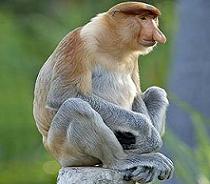
 |
|
|
|---|
| There are seven national parks, numerous reserves and other types of protected areas in Kalimantan. These include: |

|
|---|
Kutai National Park has an area of almost 200,000 ha, created to protect flora and fauna. This area encompasses a broad lowland region that extends from the coast to 65 km inland, with a width of about 40 km. It contains at least six forest structural types; more than 800 species of plants (with an average of 250 species per ha); and more than 300 species of birds, 80% of which are endemic to Kalimantan (BAPPENAS 2003). It has also been nominated as a center for plant diversity (IUCN 1990, MacKinnon 1990). This Park has suffered as much as any of Indonesia’s National Parks over the last five years. Momberg et al. (1998) classified the Park as severely degraded, and this degradation continues unabated to the present. There has been encroachment on all of its boundaries, but particularly on the western half; much of the vland has been claimed by local villagers who have converted large tracts of it to gardens. Additionally, intense fires during the 1980s and 1990s from the west, south and north have degraded large areas and provided opportunities for loggers to enter the Park and cull trees killed by fire. In the last several years, there has also been a great increase in illegal logging in the Park, the center of which is now traversed by logging roads. Many non-timber forest products have also been removed from the Park and hunting is extensive. The Nature Conservancy’s ecoregional plan for East Kalimantan lists all protected areas, including Kutai National Park, as a priority conservation area, despite its degradation (Kitchener et al. 2002).
Tanjung Puting National Park is a coastal site that does not rise more than 100 m above sea level. It has freshwater habitats, Heath Forests, Mangrove Forests and Peat Swamp Forests. It has been the focus of a 19-year intensive research program to study the ecology of the orangutan and associated primates in the Park and the effect of fire on the vegetation and the orangutan. In 1999, encroachment on the Park from neighboring villagers and migrants resulted in direct conflicts with researchers in the Park, and their research centers were vandalized. Illegal logging and hunting continues unabated. The wild fires of the 1990s burnt large areas of the fringes of the peat swamps. |
|---|
Source : Report on Biodiversity and Tropical Forests in Indonesia, USAID/Indonesia, 2004. Prepared by : (1) Steve Rhee, M.E.Sc. (2) Darrell Kitchener, Ph.D. (3) Tim Brown, Ph.D. (4) Reed Merrill, M.Sc. (5) Russ Dilts, Ph.D. (6) Stacey Tighe, Ph.D.
|
 |
 |
|---|
|
||||||||||||
|---|---|---|---|---|---|---|---|---|---|---|---|---|
|
|
||||||||||||